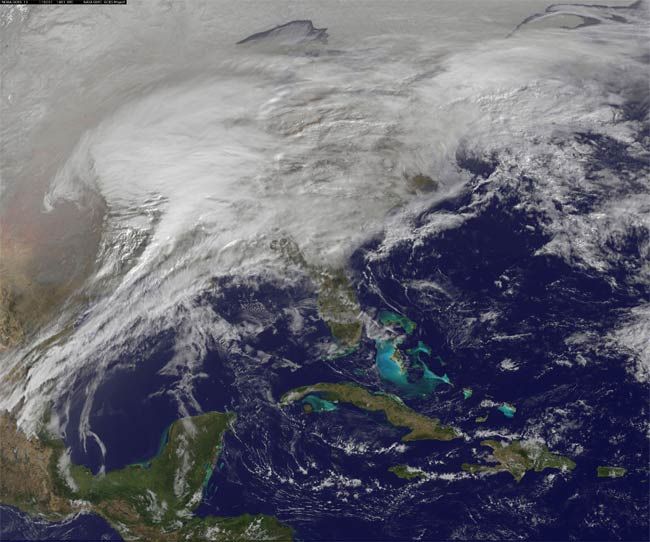With Climate Change, Expect More Monster Winter Storms

No single weather event can be directly attributed to climate change. But as the globe warms up, Americans can expect more storms like the one bearing down on much of the United States, scientists say.
That's not because the Feb. 1 storm can be linked to rising atmospheric carbon dioxide levels or increasing global temperature – again, such a connection is impossible to make – but, according to climatologists, an increased propensity for winter storms is exactly what you'd expect in a warming world.
"There's no inconsistency at all," Michael Mann, the director of the Penn State Earth System Science Center, told LiveScience. "If anything, this is what the models project: that we see more of these very large snowfalls."
Climate versus weather
Questions about climate often pop up when the weather is extreme. Droughts and heat waves trigger comments on the scourge of carbon dioxide. During winter storms like the one currently lashing much of the East and Midwest, skeptics question why they have to dig out their car from snowdrifts in a supposedly warming world.
Pinning climate change angst on a single weather system makes no sense, climatologists say.
"Climate is the statistics of weather over the long term," Ken Caldeira, a senior scientist at the Carnegie Institute for Science at Stanford University, told LiveScience. "No specific weather event can by itself confirm or disprove the body of scientific knowledge associated with climate change."
Sign up for the Live Science daily newsletter now
Get the world’s most fascinating discoveries delivered straight to your inbox.
Instead, Mann said, climate change is like a pair of loaded dice. If you erase the 5 on one side of a die and replace it with a 6, you'll roll twice as many 6s. There's no way of knowing which of those 6s you would have rolled without loading the die, just as there's no way of knowing which hurricane would have fizzled without climate change.
In the long term, though, the global warming trend becomes clear.
"Climate change is an intrinsic part now of every roll of the die," Mann said. "We've stacked the odds."
Stronger storms
But stacked the odds for what? Models suggest the answer is bigger storms. Warmer air in the atmosphere can hold more moisture, Mann said, and the condensation of that moisture puts more energy into storm systems.
"It's sort of a double whammy," Mann said. "The storms become more powerful and they contain more moisture."
In the United States storms might track a bit more northward, and the East Coast might see more Nor'easters, Mann said. North America isn't going to get so warm that snow disappears, he said, and when cold air hits extra-moist air, snowfalls are likely to get larger. Some research has suggested that global warming could fuel bigger thunderstorms as well.
There's still a lot of noise in the data that needs to be sorted out before climatologists can predict localized weather effects from climate change, said Rutgers University professor David Robinson, who is the state climatologist of New Jersey.
"How many major floods do we have to have in a 20-year period before we say, 'Well, that's unprecedented'? And then you have to ask, 'But could it still happen naturally?'" Robinson said. "That could take years. That could take decades."
Slow and steady
Robinson is currently looking into whether severe winter weather has changed over the past century. He and his colleagues are analyzing records of major winter snowfalls.
"The tricky part is we could actually have the snow signal temporarily hidden by the fact that you could have some larger snows that would keep your annual averages commensurate with what they had been in the past, even though change is occurring," Robinson said. "So you have to look at the change in the way the snow is falling, not necessarily the quantity of snow."
All of this work takes time, Robinson said. Major changes will become apparent more quickly, he said, while subtle signals may take half a century to detect.
"Meteorologists get instant gratification or instant disdain," Robinson said. "The one thing that is required of climatologists is patience."
- Earth in the Balance: 7 Crucial Tipping Points
- 10 Surprising Results of Global Warming
- The World's Weirdest Weather
You can follow LiveScience Senior Writer Stephanie Pappas on Twitter @sipappas.

Stephanie Pappas is a contributing writer for Live Science, covering topics ranging from geoscience to archaeology to the human brain and behavior. She was previously a senior writer for Live Science but is now a freelancer based in Denver, Colorado, and regularly contributes to Scientific American and The Monitor, the monthly magazine of the American Psychological Association. Stephanie received a bachelor's degree in psychology from the University of South Carolina and a graduate certificate in science communication from the University of California, Santa Cruz.











